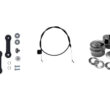Are you considering buying a second-hand car that’s over 10 years old? Don’t make a costly mistake! Here are some key things to keep in mind:
Price: Don’t overpay for an older car, no matter how good it looks or runs.
Reliability: Choose a car with a good reputation for reliability, especially since wear and tear can be greater on older cars. Look for a well-maintained car with a good service history.
Maintenance: Be prepared for more maintenance than with a newer car. Find a reliable mechanic to service your car and check it regularly for potential problems.
Safety: Safety is crucial when buying an older car. Look for features like airbags, anti-lock brakes, and traction control. Check the car’s safety rating.
In short, there’s no definitive answer to whether a 10-year-old car is too old. But if you follow these guidelines and choose a reliable, well-maintained, and safe car, you can find a great ride that will last you for years to come.
Price and Reliability: The Main Concerns
As a car blogger, one of the most frequently asked questions I receive is whether a 10-year-old car is too old to buy. The answer is no, it is not too old if you adhere to the right guidelines. The two main concerns when it comes to purchasing an older car are the price and the reliability. With these two factors in mind, you can make a smart decision when buying a car that is over 10 years old.
Don’t Overpay: Knowing the Value of a 10-Year-Old Car
When buying an older car like a 10-year-old vehicle, it is important to know its value. You should not pay more than what the car is worth. Do your research and find out what the average price is for a car of that make, model, and age. Be wary of dealers or private sellers who are asking for more than the car is worth. This is particularly important for cars with a lot of miles or wear and tear, as these factors can significantly impact the car’s value.
Choosing the Right Car: Reputation for Reliability
When buying an older car, one of the most important things to consider is its reliability. You should choose a car that has a good reputation for reliability. This will increase the chances of the car lasting for a few more years without major issues. Consider doing a bit of research or asking for recommendations from other car enthusiasts to find out which models have a good track record for reliability.
Age Is Just a Number: Judge the Car’s Condition Instead
When buying an older car, it is crucial to judge the car’s condition rather than its age. A well-maintained car that is over 10 years old could be a better investment than a newer car that has been poorly maintained. Look for signs of wear and tear, such as rust, dings, and scratches. Take the car for a test drive and listen for any strange noises or vibrations. A thorough inspection by a professional mechanic can also help you assess the car’s condition.
- Inspect for rust damage – Rust damage can severely impact the lifespan of a car, so be sure to check for rust damage on the body or undercarriage.
- Check the tires – Tires are one of the most important parts of a car, so be sure to check the tread wear and inflation levels.
- Assess the interior – Torn seats, cracked dashboards, and other signs of wear and tear on the inside of a car could indicate poor maintenance or excessive use.
Maintain It Well: How Proper Maintenance Can Extend a Car’s Lifespan
The key to keeping an older car running well is proper maintenance. Regular oil changes, tune-ups, and other preventative maintenance can extend the lifespan of a car for many years. As the owner of an older car, it is your responsibility to keep up with its maintenance needs. Keep detailed records of all maintenance and repairs to help you avoid any major issues down the road.
Parts Availability: The Importance of Finding Replacement Parts
When buying an older car, it is important to consider the availability of replacement parts. Some older models may have discontinued parts that can be difficult or expensive to replace. Research the availability of replacement parts before you buy an older car to ensure that you won’t have trouble finding parts down the line.
Driving a Classic: The Benefits and Joys of Owning an Older Car
Finally, owning an older car can be an enjoyable experience. Many car enthusiasts prefer the classic look and feel of older cars. Owning an older car can also be a great way to save money, as older cars often have lower insurance and registration fees. In the end, it all comes down to personal preference and budget.
As you can see, there are many factors to consider when buying a 10-year-old car. With the right research and maintenance, however, an older car can be a great investment. Remember to consider factors like price, reliability, and availability of replacement parts when making your decision.



